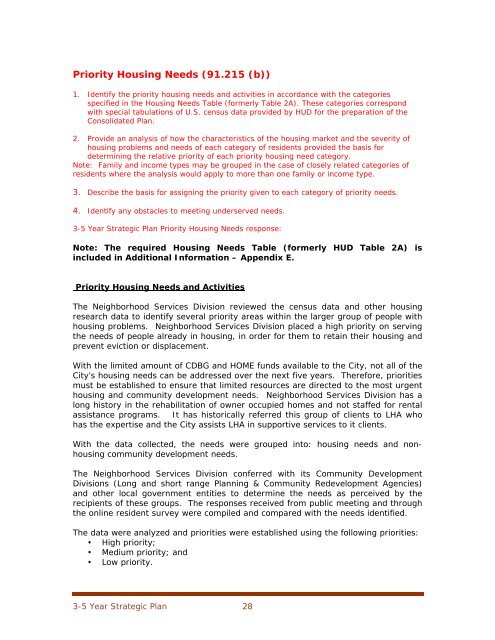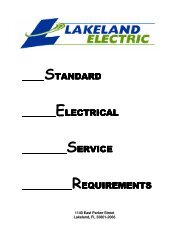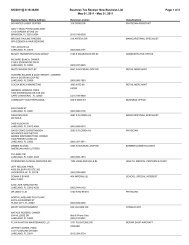CONSOLIDATED PLAN & STRATEGY 5-YEAR ... - City of Lakeland
CONSOLIDATED PLAN & STRATEGY 5-YEAR ... - City of Lakeland
CONSOLIDATED PLAN & STRATEGY 5-YEAR ... - City of Lakeland
You also want an ePaper? Increase the reach of your titles
YUMPU automatically turns print PDFs into web optimized ePapers that Google loves.
Priority Housing Needs (91.215 (b))<br />
1. Identify the priority housing needs and activities in accordance with the categories<br />
specified in the Housing Needs Table (formerly Table 2A). These categories correspond<br />
with special tabulations <strong>of</strong> U.S. census data provided by HUD for the preparation <strong>of</strong> the<br />
Consolidated Plan.<br />
2. Provide an analysis <strong>of</strong> how the characteristics <strong>of</strong> the housing market and the severity <strong>of</strong><br />
housing problems and needs <strong>of</strong> each category <strong>of</strong> residents provided the basis for<br />
determining the relative priority <strong>of</strong> each priority housing need category.<br />
Note: Family and income types may be grouped in the case <strong>of</strong> closely related categories <strong>of</strong><br />
residents where the analysis would apply to more than one family or income type.<br />
3. Describe the basis for assigning the priority given to each category <strong>of</strong> priority needs.<br />
4. Identify any obstacles to meeting underserved needs.<br />
3-5 Year Strategic Plan Priority Housing Needs response:<br />
Note: The required Housing Needs Table (formerly HUD Table 2A) is<br />
included in Additional Information – Appendix E.<br />
Priority Housing Needs and Activities<br />
The Neighborhood Services Division reviewed the census data and other housing<br />
research data to identify several priority areas within the larger group <strong>of</strong> people with<br />
housing problems. Neighborhood Services Division placed a high priority on serving<br />
the needs <strong>of</strong> people already in housing, in order for them to retain their housing and<br />
prevent eviction or displacement.<br />
With the limited amount <strong>of</strong> CDBG and HOME funds available to the <strong>City</strong>, not all <strong>of</strong> the<br />
<strong>City</strong>’s housing needs can be addressed over the next five years. Therefore, priorities<br />
must be established to ensure that limited resources are directed to the most urgent<br />
housing and community development needs. Neighborhood Services Division has a<br />
long history in the rehabilitation <strong>of</strong> owner occupied homes and not staffed for rental<br />
assistance programs. It has historically referred this group <strong>of</strong> clients to LHA who<br />
has the expertise and the <strong>City</strong> assists LHA in supportive services to it clients.<br />
With the data collected, the needs were grouped into: housing needs and nonhousing<br />
community development needs.<br />
The Neighborhood Services Division conferred with its Community Development<br />
Divisions (Long and short range Planning & Community Redevelopment Agencies)<br />
and other local government entities to determine the needs as perceived by the<br />
recipients <strong>of</strong> these groups. The responses received from public meeting and through<br />
the online resident survey were compiled and compared with the needs identified.<br />
The data were analyzed and priorities were established using the following priorities:<br />
• High priority;<br />
• Medium priority; and<br />
• Low priority.<br />
3-5 Year Strategic Plan 28
















